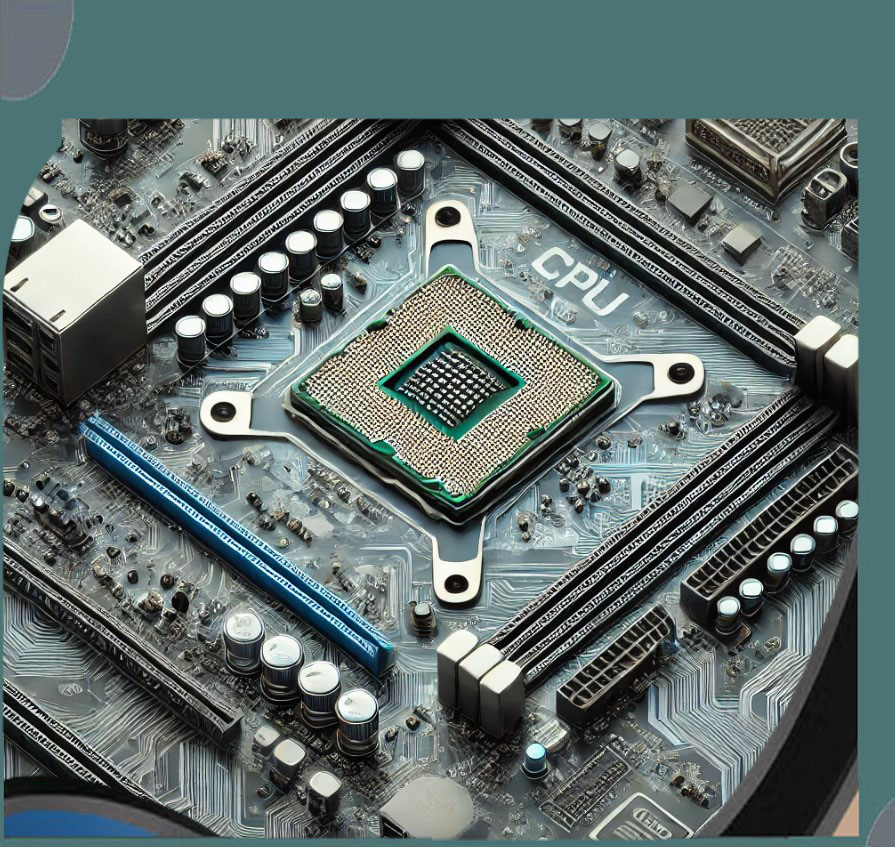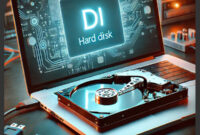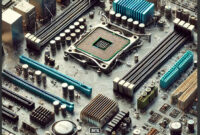Understanding the Function of a Motherboard: The Heart of Your Computer
The motherboard is often referred to as the heart of a computer, and for good reason. It serves as the central hub that connects all the components of a system, allowing them to communicate and work together seamlessly. Without a motherboard, none of the hardware inside your computer could function. In this article, we’ll delve into the essential functions of the motherboard and how it contributes to the overall performance of your machine.
What is a Motherboard?
A motherboard is a large printed circuit board (PCB) that holds the key components of a computer, including the Central Processing Unit (CPU), Random Access Memory (RAM), and expansion slots for peripherals. It also provides connectors for devices like storage drives, power supplies, and input/output (I/O) ports such as USB and HDMI.
In simple terms, the motherboard is the platform that all components plug into, enabling them to communicate and share data.
Key Functions of a Motherboard
The primary function of the motherboard is to act as the main communication center for all the computer’s hardware. It ensures that the CPU, RAM, storage, and peripherals work in harmony. Below are the key functions of a motherboard.
1. Hosting the Central Processing Unit (CPU)
One of the most critical functions of a motherboard is to house the CPU or processor. The CPU, often described as the “brain” of the computer, performs calculations and executes commands. The motherboard provides the CPU socket into which the processor is inserted. This socket connects the CPU to the rest of the system, allowing it to communicate with other components such as RAM and storage devices.
Modern motherboards also provide a chipset, which helps manage communication between the CPU and other parts of the system, ensuring smooth operation.
2. Memory (RAM) Management
Another crucial function of the motherboard is to manage RAM. RAM is temporary storage used by the CPU to hold data that is actively being worked on. The motherboard provides DIMM (Dual In-Line Memory Module) slots, which allow users to install RAM sticks.
The number of RAM slots can vary depending on the size and type of motherboard, but they all serve the same purpose—providing a high-speed data transfer channel between the CPU and memory. Without sufficient RAM, a system will struggle to handle multiple applications or large datasets, slowing down performance.
3. Power Distribution
The motherboard also distributes power to all the components of the system. It has specific connectors for the power supply unit (PSU), which converts electricity from the wall into a form that the computer can use. From there, the motherboard channels this power to the CPU, RAM, storage drives, and peripherals.
Motherboards come equipped with ATX power connectors, usually a 24-pin main power connector and smaller 4- or 8-pin connectors for the CPU. These ensure that every component receives the necessary power to operate efficiently.
4. Expansion and Peripheral Slots
Motherboards feature various expansion slots that allow you to add additional components to your system. These slots include PCIe (Peripheral Component Interconnect Express) slots for graphics cards, network cards, and sound cards. PCIe slots are essential for upgrading a computer’s capabilities, such as enhancing gaming performance with a powerful GPU.
In addition to PCIe slots, motherboards have M.2 slots for modern storage devices, like solid-state drives (SSDs), which offer faster read and write speeds compared to traditional hard drives. The ability to expand storage, processing power, and other functionalities through these slots makes the motherboard highly versatile.
5. Connectivity for External Devices
Motherboards provide a variety of ports for connecting external devices like keyboards, mice, printers, and monitors. These include:
- USB ports (for connecting peripherals)
- HDMI or DisplayPort (for connecting monitors)
- Ethernet ports (for wired internet connectivity)
- Audio jacks (for connecting speakers or headphones)
In recent years, USB-C and Thunderbolt ports have become more common, allowing for faster data transfer rates and the ability to charge devices directly through the port.
6. BIOS and Firmware Control
The BIOS (Basic Input/Output System) is embedded in the motherboard and controls the system’s most basic functions. It runs a POST (Power-On Self Test) when the system starts to check if all components are functioning correctly. The BIOS also allows users to configure system settings such as boot order and CPU overclocking.
Modern motherboards often come with a UEFI (Unified Extensible Firmware Interface), which is more advanced than traditional BIOS. UEFI provides a graphical interface and supports larger storage drives.
7. Data Communication Between Components
All the components installed on or connected to the motherboard communicate through the bus system. The bus refers to the pathways through which data travels between the CPU, memory, storage, and peripheral devices. There are different types of buses, such as the data bus, address bus, and control bus, each handling specific tasks within the computer.
The motherboard plays a crucial role in managing these buses and ensuring that data flows smoothly between components. This communication system ensures that all parts of the computer work together efficiently.
Types of Motherboards
Motherboards come in various sizes, which are typically categorized into form factors. The form factor determines the size, shape, and features of a motherboard, as well as the type of case it can fit into. Some common types include:
- ATX (Advanced Technology eXtended): The most common form factor, ATX motherboards are full-sized and offer multiple expansion slots and features, making them suitable for high-performance computers.
- MicroATX: Smaller than ATX, but still capable of supporting most components. It’s a good choice for budget builds or smaller cases.
- Mini-ITX: Compact and ideal for small form factor PCs. However, it has fewer expansion slots, limiting its upgradability.
Choosing the right motherboard depends on your needs, whether you’re building a high-performance gaming PC or a compact, space-saving system.
Common Issues and Failures
Like any hardware component, motherboards can experience issues that affect the entire system’s functionality. Some common problems include:
- Power issues: If the motherboard fails to receive power, the entire system will not boot.
- Overheating: Poor ventilation or excessive dust buildup can cause overheating, potentially damaging the motherboard.
- Component failure: Any malfunctioning component connected to the motherboard (like RAM, CPU, or power supply) can cause the system to fail.
Regular maintenance, such as cleaning and ensuring adequate airflow, can help prolong the life of your motherboard.
Conclusion
The motherboard plays a vital role in ensuring the smooth operation of all the components within your computer. From managing data flow between the CPU, memory, and storage, to powering the entire system, the motherboard is the backbone of modern computing. Understanding its function can help you make informed decisions when upgrading or building your PC, ensuring that all parts work together efficiently for optimal performance.
As technology continues to evolve, future motherboards will likely integrate even more advanced features, allowing for faster speeds, better power management, and greater expansion capabilities.



